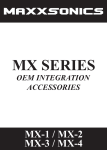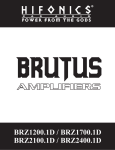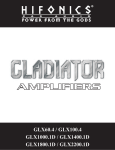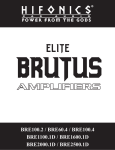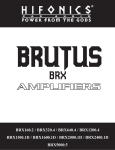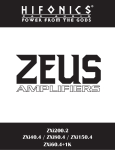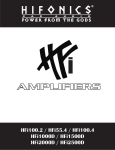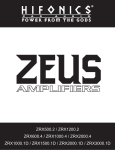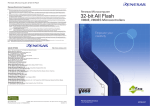Download Brutus Power Pro 1100 Specifications
Transcript
BRUTUS 25th ANNIVERSARY EDITION HIGH PERFORMANCE AMPLIFIERS As Hifonics celebrates it’s 25th anniversary of producing the finest high end car audio products available, we would like to thank you for your continued support. The BRUTUS BXi Series products have been designed to a very high level of performance, with features unavailable in any other product. All of the amplifiers have variable crossovers built in, with added touches such as subsonic filter, bass equalization and a bass remote control module that allows subsonic bass control from reach of the drivers seat. To insure years of listening pleasure, all amplifiers have a built in diagnostic mode that will detect shorted speaker leads, low impedance, dangerous high temperatures, DC shorts and will shut down the amp to prevent serious damage. INDEX PAGE General Installation Procedure.................................................................................................................1 AMPLIFIER FEATURE DESCRIPTIONS....................................................................................................2 BXi608 / BXi1208D / BXi1608D / BXi2008D / BXi2608D BXi608 (CLASS A/B) Applications............................................................................................................3 BXi1208D / BXi1608D / BXi2008D Applications.......................................................................................4 BXi2608D Applications..............................................................................................................................5 Setting up systems after installation for best performance...................................................................6 Trouble Shooting and Diagnostics...........................................................................................................7 Features and Specifications......................................................................................................................8 Product Warranty........................................................................................................................................9 The contents of this manual may not be reproduced or copied without thewritten consent of MAXXSONICS USA, Inc. GENERAL INSTALLATION PROCEDURE System Design The success of any car stereo system relies on several factors, such as the system design, execution of the installation, and system setup. Please remember that any system is only as good as its weakest link. Please remember that higher power systems are not necessarily useful purely for high sound pressure levels, but also to establish a headroom capability, to reproduce musical peaks cleanly without distortion. Lower power amplifiers will clip earlier than their more powerful cousins, and cause loudspeaker failure when overdriven, due to the harmonics generated by a clipped signal, thus overheating voice coils. Amplifiers should be mounted with the fins running horizontally for best convection cooling, to minimize overheating. Purchase the best quality RCA cables you can afford, for reliability and less engine noise interference in the audio system. Installation WOOD It is highly recommended that the amplifier be mounted to a board of MDF or other solid structure using the 4 mounting screws provided. Avoid mounting the amplifier to metal as this can introduce noise and other unwanted issues. When mounting the amplifier, ensure that it is mounted HORIZONTALLY, as shown in the diagram above, for optimal heat dissipation. Mounting amplifiers to speaker enclosures is not recommended as this can cause damage to the amplifier components. When choosing a location for mounting the amplifier, ensure that you check for clearance from wires, gas tank, electrical devices and brake lines etc. General: Run the wiring so that RCA cables are at least 18“ away from power and speaker cables. Keep RCA cables away from electrical devices in the vehicle that can cause electrical noise, such as electric fuel pumps, emission control modules and other on-board electronic modules. Power and ground connections(see the features matrix on page 8 for proper gauge cables per amplifier): Use a sufficient gauge power cable and ground cable using the chart below as reference to what size wire you require. Brutus series amplifiers require at least 4 gauge power wire. In a multi amplifier system, add the total value of the manufacture recommended fusing to get your total system amperage. Some applications may require multiple runs of power wire to meet the system requirements. In multi amplifier systems it is advisable to mount a large enough fuse right at the battery, and run one or multiple +12 volt power cables to a fused distribution block near the amplifiers. It is then a simple matter to connect the +12 volt terminal of each amplifier to the distribution block. During this process, please ensure that the main power fuse is removed to avoid shorting the electrical system. The main fuse must be within 12” of the vehicles battery. Ground each amplifier with as short a ground lead as possible directly to the vehicle chassis using at least 4 gauge wire or equivalent to the size of the amplifiers’ power wire. Use a ground distribution block, if you wish, but it is extremely important to keep the main ground lead from this distribution block to the chassis as short as possible , not more than 12“. The ground connection integrity to the chassis is very important, and the best way to achieve a good, solid electrical and mechanical contact is to use a large round crimp lug, crimped and soldered to the ground cable. The next step is to scrape the paint off the vehicle chassis , slightly larger than the ground lug, at the connection point. Drill a clearance hole in the chassis, the same size as the lug hole, and use a bolt, spring washer and nut to securely fasten the ground lug. Use petroleum jelly to coat the bolt/lug connection, to prevent oxidization with time. TIP: Use the same approach when installing head units, equalizers or any audio equipment for that matter - run short individual grounds from each piece directly to the vehicle chassis, to minimize ground loops and system noise. All power, ground and speaker connections should be crimped and soldered for reliability. Make sure that none of the cable insulation can chafe against exposed metal in the vehicle, causing short circuits to the chassis. NOTE: This Matrix is a general rule of thumb. Please refer to the manufacturers specific requirements. Brutus specifications can be found on page 8. Safe connection sequence: After all cables are run, connect speaker wires to the speakers and amplifiers, then run and plug in RCA cables. Next, connect all power, ground, and remote turn on leads. Now connect all +12 volt cables to the amplifier/s and distribution blocks and fuse holders. Finally, connect the main +12 volt cable to the battery, with the main fuse removed, and we are almost ready to power up the system. Power up the system: The following procedure may seem like overkill, but there is nothing more frustrating when turning on a system for the first time, and it does not work properly immediately. First, make sure the head unit is off, and turn all level controls to minimum (counterclockwise), including the head unit volume control. Set all equalizers to 0 dB (no boost), and all crossover frequency controls at approximate frequencies, as recommended by the loudspeaker manufacturer. Set all input selector and crossover switches as required for the application. Remove all amplifier fuses, and insert the main fuse at the battery. If the fuse does not blow, you can insert the fuse in one of the amplifiers, and we are ready to turn on the system. Turn the head unit on, insert a CD, or select a radio station, and increase the head unit volume control. If the system sounds fine, turn off the head unit, and install fuses in the remaining amplifiers, one by one, till the complete system is powered up and functioning properly. 1 AMPLIFIER FEATURE DESCRIPTIONS BXi608 A/B MONO AMPLIFIER INPUT LEVEL PHASE REMOTE BASS EQ SUB SONIC LOW PASS POWER L PROTECT 9V 0.2V 0 180 0 10dB 15 35Hz 35 250Hz R BXi1208D / BXi1608D / BXi2008D MONO AMPLIFIERS INPUT OUTPUT L BALANCED INPUT LEVEL PHASE REMOTE BASS EQ SUB SONIC LOW PASS POWER L PROTECT 9V R 0.2V 0 180 0 10dB 15 35Hz 35 250Hz R BXi2608D MONO AMPLIFIER INPUT L OUTPUT BALANCED INPUT LEVEL REMOTE BASS EQ SUB SONIC LOW PASS PWR IN L 9V R PHASE R 0.2V 0 180 0 10dB 15 35Hz 35 250Hz PRT OUTPUT MASTER INPUT SLAVE OUT The line input signal is routed directly to the line output RCA’s jacks regardless of the crossover settings. BOOST The REMOTE jack allows the addition of the Bass Remote module which controls the BASS EQ signal. The Bass Remote module is NOT a volume control, but rather a Bass Boost at 45Hz .- SUBSONIC allows control from 15Hz to 35Hz - BASS EQ allows control from 0dB to 10dB HFR 3 MI N MAXX - LOW PASS allows control from 35Hz to 250Hz The 1 channel mono amplifiers are capable of 4, 2 & 1 ohm loads and can be used in any - PHASE shift allows 0 degrees to 180 degreesof the “bi-amplifier” systems described in the 2 and 4 channel Zeus, Titan and GEN XX LEVEL: allows you to match the amplifier input level (gain) to the Radio/CD player output level. installation manuals. - POWER: indicates that the amp has power, ground and remote turn-on input via a green L.E.D. - PROTECT: indicates that the amplifier has detected a fault and will not operate. CAUTION: DO NOT OPERATE ANY AMPLIFIER BELOW THE INTENDED IMPEDANCE. There are several possible problems that can cause the amplifier to go into the protect YOU WILL CAUSE DAMAGE TO THE AMPLIFIER THAT WILL NOT BE COVERED mode. See the trouble shooting guide in the back of the manual for details. UNDER THE WARRANTY PRINTED IN THE BACK OF THE MANUAL. - BALANCED INPUT: Accepts line level balanced input from 0.4v to 18v. The XX-BLD can be Mono amps: 4, 2 & 1 Ohms. used as a balanced line driver. Amplifier Feature Descriptions: BALANCED INPUT: Accepts balanced line inputs from 0.04 volts to 18 volts for the optional MMBLD-1 balanced line driver. LINE INPUT: The Line Inputs are the RCA input jacks labeled “LINE INPUT”. This is where the Radio/CD player RCA outputs connect to. The Line Inputs accept unbalanced RCA inputs from 0.2 volts to 9 volts. LINE OUTPUT: The Line Outputs are a direct pass-through from the inputs. The RCA input signal from the radio/CD player is routed through the amplifier and out of the Line Outputs. The outputs would connect to another amp Line Inputs in a multi-amp set-up.This allows you to daisy chain multiple amps from a single set of RCA cables from the radio/CD player. LEVEL: The input level control allows you to match the amplifier input sensitivity to the output level of the RADIO/CD player from 0.2 Volts to 9 volts when using unbalanced RCA cables. The Level control needs to be adjusted to match the Line Level Sensitivity (this is the amount of voltage the radio/CD player RCA’s provide. Example: If the radio/CD player Line Level Sensitivity is 4 volts, adjust the amp Level control to 4 volts. SUBSONIC: The variable Subsonic filter is for subwoofer applications that require very low tuning frequencies typically around 15Hz - 35Hz. BASS EQ: Variable Bass Boost from 0 to 10dB at a fixed 45Hz. LOW PASS: Fully adjustable crossover from 35 to 250Hz. PHASE SHIFT: The Phase Shift is fully adjustable from 0 to 180 degrees and this allows you to control the timing of the subwoofers. This is commonly used when the subwoofers are installed in each front door. SYSTEM DIAGNOSTICS: The amplifier has built-in monitoring devices and protection circuits that monitor all vital functions of the amplifier. The Protection light does not come on to indicate there is a failure, it comes on when it detects an improper operation. Common issues that cause Protection status are: - THERMAL: The amp has an internal temperature sensor that will automatically shut off the amp if it reaches dangerous temperature levels. - OVER LOAD: If the amp is run at an improper impedance, the amp will shut down. If you are “CLIPPING” speakers / subwoofer(s), the light will blink to indicate a hard clip. - DC PROTECT: In the unlikely event the amp should internally fail, the amp will shut down to prevent a DC voltage output to the speakers or sub. REMOTE: The HFR-3 Bass Remote Module plugs into the Renmote jack and allows you to adjust the Bass Boost from 0 to 10dB. MASTER/SLAVE: Allows for Linking/Strapping two amplifiers to a single subwoofer or multiple subwoofers that are wired together. (BXi2608D) 2 BXi608 A/B MONO AMPLIFIER APPLICATIONS Basic application Interconnect cable checklist: - Connect the line inputs to a Radio/CD RCA outputs or line output of the full range primary amplifier with good quality RCA cables. A “Y” adapter may be needed as shown in the diagram. - Use at least 16 gauge speaker wiring. These amplifiers have dual speaker terminals, simplifying the hookup of multiple speakers Crossover frequency control checklist: - LOW PASS: 35Hz to 250Hz - SUBSONIC:15 Hz to 35 Hz - BASS EQ: 0 to 10dB - PHASE: 0 to 180 degrees Minimum final loudspeaker impedance: - 1 ohm. FULL RANGE STEREO LINE INPUT Y-ADAPTOR NOT USED can use the Radio/CD designated mono line output *orNote:a fullYourange stereo line output. For full range stereo line output, Level control checklist: - Refer to the section “Setting up systems after installation for best performance” you will need an optional “Y-Adaptor” as shown MONO SUBWOOFER INPUT - L + GND 250Hz LOW PASS 35Hz 35 SUB SONIC 10dB 15 POWER REM +12V REMOTE BASS EQ 0 MI N MAXX + PHASE 180 HFR 3 - LEVEL 0.2V 0 BOOST SPEAKER 9V * R DESIGNATED MONO LINE INPUT TO BATTERY +12v VIA FUSE REMOTE TURN-ON CHASSIS GROUND POWER PROTECT Dual Subwoofer Application PARALLEL MONO SUBWOOFERS 2-OHMS EACH MINIMUM INPUT 180 PHASE - POWER REM +12V 250Hz LOW PASS 35Hz 35 SUB SONIC 10dB 15 GND 0 REMOTE BASS EQ MI N MAXX MONO SUBWOOFERS + + 0.2V 0 LEVEL HFR 3 SPEAKER 9V BOOST L * R DESIGNATED MONO LINE INPUT TO BATTERY +12v VIA FUSE REMOTE TURN-ON CHASSIS GROUND POWER PROTECT 3 BXi1208D / BXi1608D / BXi2008D MONO AMPLIFIER APPLICATIONS Basic application Interconnect cable checklist: - Connect the line inputs to a Radio/CD RCA outputs or line output of the full range primary amplifier with good quality RCA cables. A “Y” adapter may be needed as shown in the diagram. - Use at least 16 gauge speaker wiring. These amplifiers have dual speaker terminals, simplifying the hookup of multiple speakers Crossover frequency control checklist: - LOW PASS: 35Hz to 250Hz - SUBSONIC:15 Hz to 35 Hz - BASS EQ: 0 to 10dB - PHASE: 0 to 180 degrees Minimum final loudspeaker impedance: - 1 ohm. FULL RANGE STEREO LINE INPUT Y-ADAPTOR NOT USED can use the Radio/CD designated mono line output *orNote:a fullYourange stereo line output. For full range stereo line output, Level control checklist: - Refer to the section “Setting up systems after installation for best performance” you will need an optional “Y-Adaptor” as shown DESIGNATED MONO LINE INPUT * L R L INPUT R MONO SUBWOOFER - + SPEAKER LEVEL PHASE 0.2V 0 - BALANCED INPUT 9V 180 REMOTE BOOST 15 SUB SONIC 35Hz 250Hz LOW PASS 35 POWER REM +12V MI N MAXX GND 10dB BASS EQ 0 HFR 3 + OUTPUT STEREO LINE OUTPUT TO BATTERY +12v VIA FUSE REMOTE TURN-ON CHASSIS GROUND POWER PROTECT Dual Subwoofer Application PARALLEL MONO SUBWOOFERS 2-OHMS EACH MINIMUM *DESIGNATED MONO LINE INPUT L R INPUT PHASE 0.2V 0 LEVEL + 180 REMOTE 35Hz SUB SONIC 250Hz LOW PASS 35 POWER REM +12V 15 GND 10dB BASS EQ 0 POWER PROTECT 4 - 9V MI N MAXX SPEAKER BALANCED INPUT HFR 3 MONO SUBWOOFERS - L BOOST + OUTPUT R STEREO LINE OUTPUT TO BATTERY +12v VIA FUSE REMOTE TURN-ON CHASSIS GROUND BXi2608D MONO AMPLIFIER APPLICATIONS Basic application SINGLE AMP INSTALLATION PROCEDURE: 1. Connect the amp LINE INPUTS to the Radio/CD player full range or mono line out puts with good quality RCA interconnect cables. 2. Plug in the HFR-3 bass remote module into the amp REMOTE INPUT jack. 3. Route a 0 gauge power cables directly to the vehicle battery with an in-line fuse. 4. Connect a 0 gauge ground cables directly to chassis ground with in 36” of the amp. - Be sure to remove any paint or primer from the ground point. - Use a nut, bolt and lock washer to secure the ground cable to the chassis ground. 5. Connect the subwoofer(s) in accordance to the diagrams below. 6. Make sure the MASTER/SLAVE switch is in the MASTER position. Note: The amplifier will not work if the MASTER/SLAVE switch is in the Slave position FULL RANGE STEREO LINE INPUT NOT USED Note: You can use the Radio/CD designated mono line output or a full range stereo line output. For full range stereo line output, you will need an optional “Y-Adaptor” as shown. MONO SUBWOOFER L R INPUT + L R * + BALANCED INPUT - PHASE 0.2V 0 LEVEL SPEAKER 9V REMOTE REM 180 BOOST REMOTE TURN-ON BASS EQ 0 HFR 3 PARALLEL MONO SUBWOOFERS 2 OHMS EACH MINIMUM OUTPUT DESIGNATED MONO LINE INPUT Y-ADAPTOR MI N MAXX 10dB 15 POWER +12V GND REM - SPEAKER - PWR 250Hz PRT LOW PASS 35 POWER +12V GND 35Hz SUB SONIC + + CHASSIS GROUND OUTPUT MASTER INPUT SLAVE TO BATTERY + 12 Volts VIA FUSE IN OUT DUAL AMP INSTALLATION PROCEDURE: 1. Connect the amp LINE INPUTS to the Radio/CD player full range or mono line out puts with good quality RCA interconnect cables. 2. Plug in the HFR-3 bass remote module into the amp REMOTE INPUT jack on the Master amp. This will allow the Master amp to control both Master and Slave amps with just one Bass Remote. 3. Connect an RCA jumper cable from the Master amp MASTER OUTPUT to the Slave amp SLAVE INPUT. Note: This will “link” the amps so that the Master amp crossover switches will control both the Master and Slave amps. The Slave amp crossover switches will be bypassed. 4. Route two 0 gauge power cables directly to the vehicle battery with an in-line fuse. 5. Connect two 0 gauge ground cables directly to the chassis with in 36” of the amp. - Be sure to remove any paint or primer from the ground point. - Use a nut, bolt and lock washer to secure the ground cable to the chassis ground. 6. Make sure the Master amp MASTER/SLAVE switch is in the MASTER position. Make sure the Slave amp MASTER/SLAVE switch is in the SLAVE position. 7. Connect the subwoofer(s) in accordance to the diagrams below. 8. Connect a 12 gauge jumper from Master amp speaker - to Slave amp speaker - as shown below. Linking two amps for single or dual subwoofer application Amplifiers are stable to 2ohm linked - SPEAKER - + + POWER +12V GND REM - SPEAKER - + + INPUT L R + OUTPUT + BALANCED INPUT - DUAL VOICE COIL SUBWOOFER - PHASE 0.2V 0 LEVEL SPEAKER 9V MASTER 10dB BASS EQ 0 Master remote controls both amplifiers when LINKED 15 PWR 250Hz PRT LOW PASS 35 INPUT SLAVE OUTPUT MASTER INPUT SLAVE OUT POWER +12V GND 35Hz SUB SONIC IN OUTPUT MASTER IN OUT L R SINGLE VOICE COIL SUBWOOFER INPUT L R + OUTPUT + BALANCED INPUT - PHASE 0.2V 0 LEVEL SPEAKER 9V REMOTE 10dB BASS EQ 0 SLAVE REM 180 POWER +12V GND REM - SPEAKER - + PWR 250Hz PRT LOW PASS 35 OUTPUT MASTER INPUT SLAVE OUTPUT MASTER INPUT SLAVE OUT POWER +12V GND 35Hz SUB SONIC IN + POWER +12V GND REM - SPEAKER - + + TWO SINGLE COIL SUBWOOFERS 15 - + - + IN OUT MASTER OUTPUT TO SLAVE INPUT RCA JUMPER CABLE 12 GAUGE JUMPER WIRE REMOTE MI N MAXX REM 180 BOOST HFR 3 REM L R DESIGNATED MONO OUTPUT FROM HEAD UNIT POWER +12V GND 5 SETTING UP SYSTEMS AFTER INSTALLATION FOR BEST PERFORMANCE General: At this point you are ready to get more specific on the settings for your amplifier. Subsonic: This setting acts as a low frequency cut off for your system bass reproduction. The point that you set it at cuts off any frequencies from reproduction beyond this point. The 12 o’clock position is a great starting point. EXAMPLE: If you adjust the Subsonic to 25Hz, the amplifier will not play frequencies below 25Hz but will play frequencies from 25Hz to the chosen Low Pass frequency. Bass EQ: This setting is a fixed bass boost at 45Hz that is variable from 0-10dB. This feature provides impact to your bass, but if not adjusted correctly, it can be over used and cause damage to your subwoofers and amplifiers. It is best to slowly turn this setting clockwise until the desired punch is felt. It is not recommended to exceed the 12 o’clock position unless listening at a low volume or a low recording quality as this can result in high distortion and possibly clipping. Low Pass: The Low Pass control acts as a ceiling and doesn’t allow frequencies to the right of the desired setting to be reproduced. The 12 o’clock position is a great starting point. EXAMPLE: If you adjust the Low Pass to 80Hz, the amplifier will not play frequencies above 80Hz but will play frequencies from 80Hz to the chosen Subsonic frequency. Phase: The variable Phase adjustment allows you to change the relative time that the waveform meets your ear. With standard subwoofer installations where the subwoofer is behind you, the Phase should generally be at 0. When subwoofers or woofers are in the kick panels or door panels, the Phase adjustment is useful in delaying the timing of the wave meeting your ear by adjusting the potentiometer to 180 degrees. Level Control Setup: Ensure that the Level is turned completely to the left prior to turning the system on. Next you should insert a CD or cassette that you are familiar with to use as a reference, and turn the head unit volume control to about 80% of its full setting. The system sound level will of course be very low, and the following procedures will help you to match the amplifier input sensitivities properly to the head unit output signal level. It is important to match the amplifier LEVEL input sensitivity to the Radio/CD output sensitivity. This can be located in the Radio/CD manual. If the Radio/CD output sensitivity is 2 volts, then adjust the amplifier LEVEL input to 2 volts. If you are not sure what the Radio output sensitivity is, follow these general guide lines: Turn the level control up slowly, till you hear distortion, then back off a few degrees on the control. If at any point your amplifier goes into protection, you will need to turn the Level to the left a bit and then try again. If you reach a point where the output does not increase, stop turning the Level control to the right as the amplifier/subwoofer combo has reached its maxx output in this application. 6 TROUBLESHOOTING A SYSTEM The key to finding the problem in a misbehaving sound system is to isolate parts of that system in a logical fashion to track down the fault. Description of the Diagnostic system built into all HiFonics amplifiers The diagnostic system will shut down the amplifier, until reset by turning the head unit off, and back on. This state of affairs will be indicated by the front panel PROTECT LED lighting up under the following conditions: 1 - A sort circuit on the loudspeaker leads. 2 - An internal amplifier fault that causes a DC offset on the loudspeaker output. Should the amplifier go into diagnostic mode, simply disconnect all RCA and speaker leads, while keeping +12 volt, power ground and remote leads connected. 1. Now turn the amplifier back on, and if the diagnostic LED lights, the amplifier has an internal fault. 2. If not, plug the RCA cables back, and reset the amplifier. If it goes into diagnostic now, the fault lies in the input, either with bad cables or source unit. 3. If the amplifier seems ok with RCA cables plugged in, connect the speakers, one at a time, and if one of speaker or its wiring is faulty, it will activate the diagnostic system. Amplifier heatsink overheating The amplifiers will shut down when the heatsink temperature reaches 80 degrees centigrade, and turn back on once the unit has cooled down below that point. Causes of overheating: 1 - Inadequate cooling - relocate or remount to provide better natural airflow over the fins. 2 - Driving high power levels into low impedances - back off on the volume control, and/or make sure you are not loading the amplifier with less than the recommended loudspeaker impedance. Low output power 1 - Check that level controls have been set up properly. 2 - Make sure that the battery voltage, as measured at the amplifier’s +12 volt and ground terminals, is 11 volts or more. 3 - Check all +12 volt and ground connections. Fuses blowing 1 - The use of loudspeaker impedances below the recommended minimums will draw more current - check. 2 - A short on the main +12 volt cable from the battery to the vehicle chassis will cause the main fuse to blow. 3 - If an amplifier fuse blows continually, with only +12 volt, ground and remote leads connected, the amplifier may be faulty. System does not turn on 1 - Check all fuses. 2 - Check all connections. 3 - Measure the +12 volt and remote turn on voltages at the amplifier terminals. If these are non existent or low, take voltage measurements at fuse holders, distribution blocks, the head unit’s +12 volt and remote leads to localize the problem. Noise problems System noise can be divided into two categories, hiss, and electrical interference. Hiss, or white noise 1 - High levels of white noise usually occurs when amplifier level controls are turned up too high - readjust according to the procedures in section ”Setting up systems after installation for best performance” 2 - Another major problem that can cause excessive hiss, is a noisy head unit - unplug the amplifier input RCA cables, and if the hiss level reduces, the source unit is at fault. Electrical interference The inside of an automobile is a very hostile electrical environment. The multitude of electrical systems, such as the ignition system, alternator, fuel pumps, air conditioners, to mention just a few, create radiated electrical fields, as well as noise on the +12 volt supply and ground. Remember to isolate the problem - first unplug amplifier input RCA cables, if the noise is still present, check the speaker leads, if not, plug the RCA’s back, and investigate the source driving the amplifier, one component at a time. A ticking or whine that changes with engine RPM: 1 - This problem could be caused by radiation pickup of RCA cables too near to a fuel pump or a distributor, for instance, - relocate cables. 2 - Check that the head unit ground is connected straight to the vehicle chassis, and does not use factory wiring for ground. 3 - Try to supply the head unit with a clean +12 volt supply directly from the battery +, instead of using a supply from the in dash wiring/fusebox. A constant whine: This type of noise can be more difficult to pinpoint, but is usually caused by some kind of instability, causing oscillations in the system. 1 - Check all connections, especially for good grounds. 2 - Make sure that no speaker leads are shorting to exposed metal on the vehicle chassis. 3 -RCA cables are notorious for their problematic nature, so check that these are good, in particular the shield connections. 7 8 Bxi608 150 x 1 300 x 1 600 x 1 BXi1208D 450 x 1 900 x 1 1200 x 1 BXi1608D 550 x 1 1100 x 1 1600 x 1 BXi2008D 650 x 1 1300 x 1 2000 x 1 BXi2608D 850 x 1 1700 x 1 2600 x 1 Note: All features subject to change without notice Electrical Specifications Slow Un-Mute Turn-On (soft start) YES YES YES YES YES Dampening Factor >250 >250 >250 >250 >250 Signal To Noise Ratio (A-weighted) >95dB >95dB >95dB >95dB >95dB THD & Noise <0.08 <0.08 <0.08 <0.08 <0.08 Variable Input Level Control (unbalanced) 0.2V - 9V 0.2V - 9V 0.2V - 9V 0.2V - 9V 0.2V - 9V Input Level Control (balanced) 0.04V - 18V 0.04V - 18V 0.04V - 18V 0.04V - 18V 0.04V - 18V Input Impedance (un-balanced) 47k-Ohm 47k-Ohm 47k-Ohm 47k-Ohm 47k-Ohm Input Impedance (balanced) 20k-Ohm 20k-Ohm 20k-Ohm 20k-Ohm 20k-Ohm Power / Diagnostic L.E.D. Yes Yes Yes Yes Yes Protection: DC, Speaker Short, Thermal, Overload Yes Yes Yes Yes Yes Power Supply MOSFET Yes Yes Yes Yes Yes Audio Output MOSFET Yes Yes Yes Yes Yes Crossover: Variable Low Pass Filter / 24dB 35Hz - 250Hz 35Hz - 250Hz 35Hz - 250Hz 35Hz - 250Hz 35Hz - 250Hz Variable Subsonic Filter / 24dB 15Hz - 35Hz 15Hz - 35Hz 15Hz - 35Hz 15Hz - 35Hz 15Hz - 35Hz Variable Bass EQ 0dB - +10dB 0dB - +10dB 0dB - +10dB 0dB - +10dB 0dB - +10dB Phase Shift (0 - +180 degrees) Yes Yes Yes Yes Yes Connector Type: Unbalanced Inputs (RCA) Yes Yes Yes Yes Yes Balanced Inputs (DIN) Yes Yes Yes Yes Yes Line Output (RCA) Yes Yes Yes Yes Yes Speaker Terminals (molded) 12 ga. 12 ga. 12 ga. 12 ga. 12 ga. Power/Ground Terminals (molded) 4 ga. 4 ga. 4 ga. 0 ga. 0 ga. Remote Bass Module HFR-3 HFR-3 HFR-3 HFR-3 HFR-3 Fusing: 60A x 1 80A x 1 70A x 2 200A (Not Included) 250A (Not Included) Heat Sink Dimensions (L x H x W) Inches 9.84” x 2.52” x 9.45” 11.42” x 2.52” x 9.45” 14.17” x 2.52” x 9.45” 14.97” x 2.52” x 9.45” 17.72” x 2.52” x 9.45” Output Power Rating 4-Ohm load 2-Ohm load 1-Ohm load HIFONICS 25th ANNIVERSARY BRUTUS SERIES AMPLIFIER FEATURES BRUTUS SERIES Maxxsonics Limited Warranty As the manufacturer of Maxxsonics, MB Quart, Autotek, Crunch and Hifonics car audio products, Maxxsonics USA Inc. Warrants to the original consumer purchaser the amplifier to be free from defects in material and workmanship for one (1) Year from date of purchase. All other parts and accessories of the system are warrantied to be free from defects in material and workmanship for one (1) year from date of purchase. Maxxsonics will repair or replace at it’s option and free of charge during the warranty period, any system component that proves defective in materials and workmanship under normal installation, use and service provided that the product is returned to the authorized Maxxsonics dealer from where it was purchased. A photo copy of the original receipt must accompany the product being returned. Valid purchase receipts will contain the name and address of the authorized reseller. Any damage to the product as a result of misuse, abuse, accident, incorrect wiring, improper installation, alteration of date code or bar code labels, revolution, natural disaster, or any sneaky stuff because someone messed up, repair or alteration out side of our factory or authorized service centers and any thing else you have done that you should not have done is not covered. This warranty is limited to defective parts and specifically excludes any incidental or consequential damages connected therewith. This warranty is not to be construed as an insurance policy. Warranty on installation labor, removal, re-installation and freight charges are not the responsibility of Maxxsonics USA Inc. Warranty products damaged as a result of insufficient or improper packing materials are not covered by this limited warranty and such damaged product will be returned “as is” at the expense of the owner. 9













